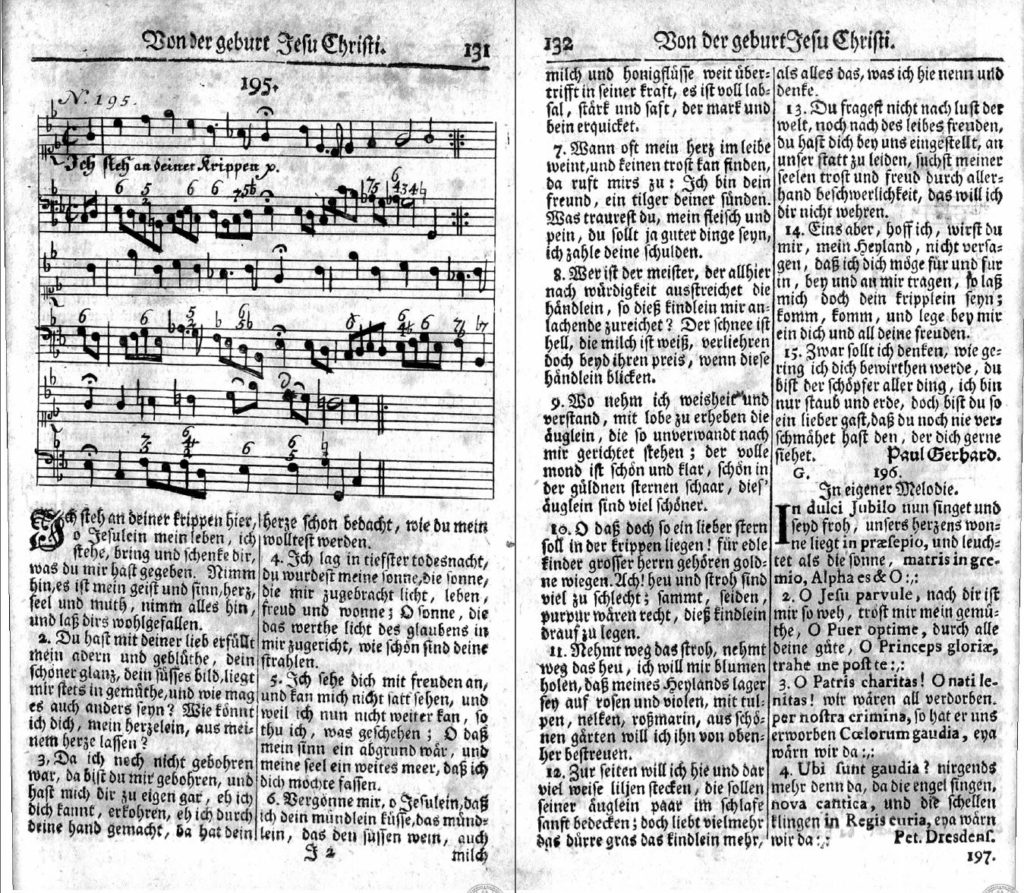Ich steh an deiner Krippen hier
I stand before thy manger
This famous song is a mystic noel, a contemplation on seeing Christ while looking at the baby in the manger. It’s kind of Kind of a Christmas’ counterpart of O Haupt voll Blut und Wunden… There the poet imagines himself standing at the cross…, here at the manger.
text
| 1. Ich steh an deiner Krippen hier, o Jesulein, mein Leben, ich stehe, bring und schenke dir, was du mir hast gegeben. Nimm hin, es ist mein Geist und Sinn, Herz, Seel und Mut, nimm alles hin und lass dirs wohlgefallen. | 1. I stand before Thy manger fair, My Jesus, Life from heaven! I come, and unto Thee I bear What Thou to me hast given. Receive it, for ’tis mind and soul, Heart, spirit, strength—receive it all, And deign to let it please Thee. |
| 4. Ich lag in tiefster Todesnacht, du wurdest meine Sonne, die Sonne, die mir zugebracht Licht, Leben, Freud und Wonne. O Sonne, die das werte Licht des Glaubens in mir zugericht, wie schön sind deine Strahlen. | 4. I lay still in death’s deepest night, Till Thou, my Sun, arising, Didst bring joy, pleasure, life, and light, My wakened soul surprising. O Sun, who dost so graciously Cause faith’s good light to dawn in me, How lovely is Thy radiance! |
| 5. Ich sehe dich mit Freuden an und kann mich nicht satt sehen, und weil ich nun nicht weiter kann, so tu ich, was geschehen. O dass mein Sinn ein Abgrund wär und meine Seel ein weites Meer, dass ich dich möchte fassen. | 5. With rapture do I gaze on Thee, Nor can enough adore Thee, Pow’r more to do is not in me, I’ll praise and bow before Thee. Oh that my mind were an abyss, My soul a sea, wide, bottomless, That so I might embrace Thee. |
What’s it about?
It’s a description of what the believer sees when he ‘beholds the Child’, knowing this child is his Saviour. Enormous gratitude, deeply felt love. It’s his return gift for the Love he has received (stanzas 1-4). Then he takes a closer look at the mouth, the hands and the eyes (st. 5-9). Wording and imagery from the Song of Songs now strongly influences Gerhardts imagination. In the mouth he sees the lips of the Bridegroom of his soul he wants to kiss (Song of Songs, ch. 1,2, cf. Ps 19,11 and 1Peter 2,2). He sees the hands stretchted out to him (Like the arms of the Saviour from the cross in the famous recitative/aria from Bach’s Matthaeuspassion), and his eyes, shining so beautifully (also Song of Songs), never loose sight of him. He is so overwhelmed (Rapture) by what he sees, that he wants to give the little child a royal cradle, finest fabric and cover him with flowers (st. 10-12a) but awakes, comes to his senses: No the King of kings, the Creator wants to be a mortal human being, carrying his fate, atoning for his sins. (12b-14) Althoug unworthy, he prays: make my body, my heart your manger, live in me forever (st. 15).
Full analysis:
Elke Axmacher, ‘„Ich steh an deiner Krippen hier”. Paul Gerhardts Weihnachtslied im Kontext der Erbauungsliteratur ‘, in :Beiträge der Paul-Gerhardt-Gesellschaft X (2016). Axmacher analyses the song using a sermon for the third day of Christmas by Johann Arndt (Postilla, 1620). Very instructive and convincing.
tune


